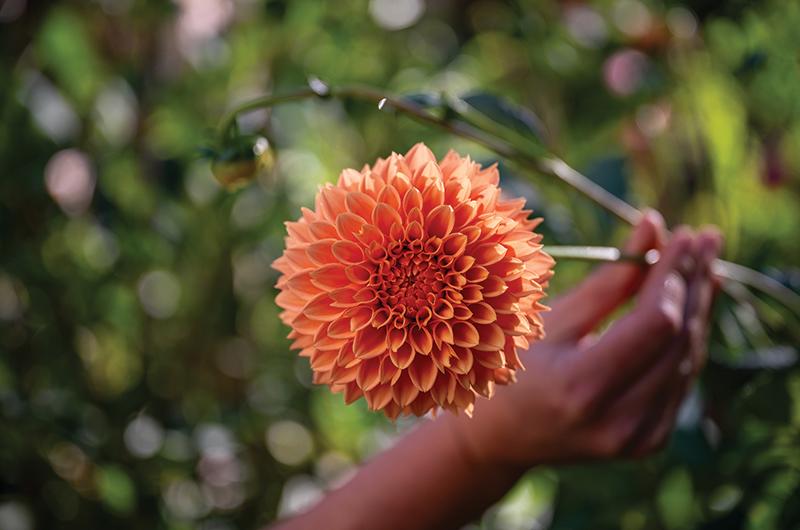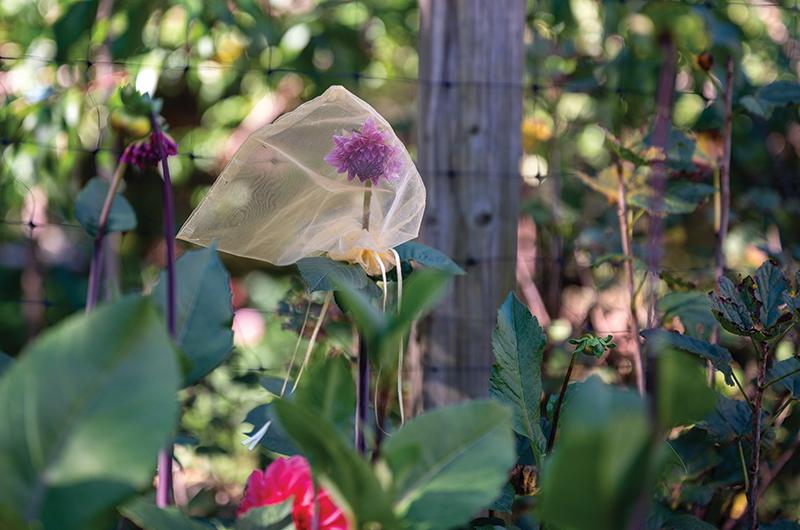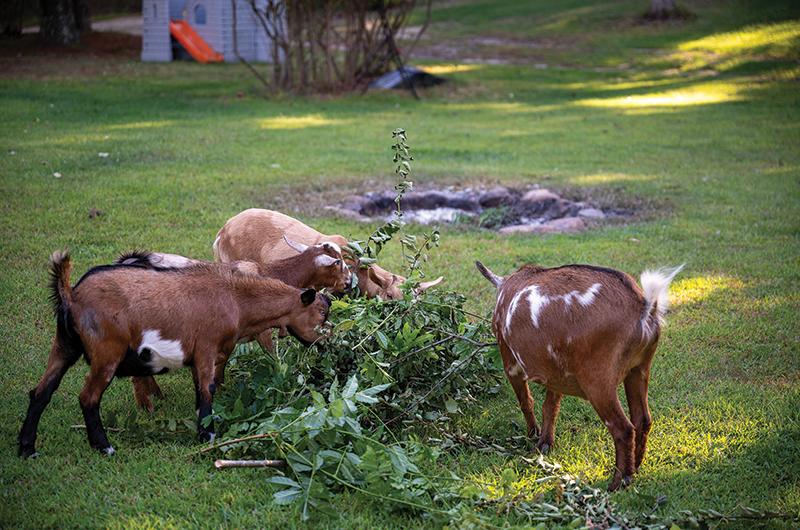Down a bumpy dirt road off Lambert’s Cove in Tisbury lies Amandine Hall’s 1.6-acre property, with a post-and-beam barn standing tall next to a shingled farmhouse. A children’s playhouse is perched on a tree-lined slope above. The magic happens in two sunny plots on either side of the wide front porch: row after row of dahlias bloom, a kaleidoscope of colors visible from every vantage point.
The dahlia itself originates from the mountains of Mexico, where it was cultivated by the Aztecs. According to the American Dahlia Society, there are now forty-two recognized species of dahlias and over 50,000 varieties, which are indexed by color, flower form, and flower size. The range is dramatic: from the smaller round honeycomb-shaped “ball” and the elegant “water lily” to the larger ten-inch-wide “dinner plate” variety, some plants grow fifteen inches tall while others grow over five feet. Colors range from white, purple, yellow, red, pink, and orange to almost-black.
Hall has her favorites, based on color, height, productivity, and ease of growing, among other factors. One of her more recent preferred varieties is sweet Suzanne, a ball-shaped variety with a green center and vibrant apricot-colored petals. But even more than love for specific varieties, she has become obsessed with the growing process.
Many farmers and gardeners love dahlias for their colors and their multitude of petals that extend out like a lion’s mane. But few people love them quite like Hall, whose passion extends beyond the dahlia’s beautiful exterior.

A trained biologist, her devotion to dahlias starts with the soil. She keeps four goats on the property expressly for their endless supply of manure that nourishes the plants, part of her belief in the importance of soil microbiomes. Hall affectionately calls the mixture her “goat crack” and mounds it at the base of each dahlia. On a breezy day last October, Hall, with a gloved hand, grabbed a handful of the rich organic matter she relies on to feed her garden. Later in the fall, once the plants die, she feeds them to her goats. “It’s a circle of life,” she said.
Each season, Hall grows more than one hundred dahlias in the typical way, by which potato-like rhizomes, known as tubers, are planted in warm, frost-free soil each spring. Over the growing season, the tubers will multiply and send up plentiful blooms until late fall or the first frost. While the blooms yielded are often reward enough for their efforts, even seasoned growers will tell you that growing dahlias can be an intensive, finicky process. Once fall arrives, the tubers need to be dug up and stored indoors until spring lest they rot in the cold, wet soil. Come spring, gardeners divide their tubers and begin the whole process again.
This undertaking isn’t for everyone. For a while even Hall wasn’t on board. Spending her childhood weekends in the seaside region of Normandy, France, she watched her mother grow dahlias. But Hall never cared for them herself. “I always found them fussy,” she explained with a laugh. Instead, she preferred growing food crops. Then, seventeen years ago, a friend gave her a bag of tubers, which she decided to plant. “I fell hard!” she said.
Today, Hall continues to fall hard for all the fuss. In addition to planting dahlia tubers, she has recently begun breeding her own dahlias – an even more time-consuming, multi-year commitment.
So what keeps her coming back to this one flower day after day, year after year? To answer that question, Hall digs deep.

After earning a degree in marine biology from the Université Pierre et Marie Curie in France and a master’s degree in shellfish biology from Bangor University in Wales, Hall was just twenty-three years old when she moved to the Island in 2001 to work as a shellfish biologist. What started as a summer hatchery position at the Martha’s Vineyard Shellfish Group evolved into a co-executive director role. In 2020 she left that role for a chemistry teaching position at the Martha’s Vineyard Regional High School. In fact, she said, one of the reasons she is so drawn to dahlias is because of the unique biology of the plant.
Dahlias grown from tubers are clones of the mother plant, meaning they will each have the same color, height, and growing characteristics as the plant from which the tubers were harvested. And yet dahlias can also be grown from seed. That’s where, according to Hall, the real fun – and mystery – of growing dahlias begins. A gardener never knows what a seed-grown dahlia will look like until it begins to bloom.
That’s because dahlias are octoploids, Hall explained – meaning they have eight sets of chromosomes, which increases the possibilities of the plant’s height, color, and growing habits, among other features. “It’s a genetically diverse plant,” she said. “And it’s a numbers game.” Color, flower shape, petal shape, and stem length are just a few of the characteristics breeders can select. Hall’s scientific background gives her unique insight into dahlia breeding. “I have an understanding of selection and breeding, and I like to experiment with new methods and gather and analyze data.”
In recent years, Hall has embraced this numbers and genetics game. Besides growing stunning blooms from tubers, she is busy creating new dahlia varieties on her recently named Long Road Flower Farm. Developing a new variety of dahlia is a long commitment. “You should grow a variety for three years to make sure it is stable before declaring it a new variety,” Hall explained.
The process goes like this: the first year, the seeds are chosen and germinated. The seedlings are grown and the breeder selects their favorites and saves the tubers. The second year, the tubers are planted and grown a second time. The third year, they’re planted again to make sure the variety is stable.

If that wasn’t enough, a breeder has to have grown the new variety in a trial garden and scored a certain number of points if he or she wants to have the varieties recorded and recognized by the American Dahlia Society. Luckily, that isn’t necessary to sell tubers, so small growers, such as Hall, are allowed to sell their new varieties after the third year.
Whichever route a breeder takes, developing a new variety requires patience and decision-making. The first year Hall started breeding, she saved three out of twenty-five tubers. The second year, with careful seed selection, she saved six out of twenty-five “for further observation.” In 2024, she planted 150 in the ground and saved and photographed thirty for observation.
Breeding your own variety allows the breeder to name it, and it is one of the best things about the process, Hall said. Naming a variety has rules: the name of the farm is first, followed by the new variety (which the breeder chooses). Hall has several varieties in the works, including Long Road firecat. It is an exquisite specimen, vibrant orange with purple petals, that she will soon send to Triple Wren Farms in Washington for evaluation. Five more varieties are going through her vetting process, and she hopes to release them this year after positive feedback from veteran growers and “flower friends.”
True to her science background, she uses an app called iCollect to catalog each bloom that includes details such as the mother parent, pollen parent, stem length, color, and shape.
At Long Road Flower Farm, each calendar season brings a new set of tasks: October is the time for harvesting and storing dahlia seeds and tubers and preparing the tubers for the overwinter. The bees sleep in the center of the flowers in the late fall and it’s quiet after a busy summer, the ground scattered with pumpkins and gourds. Seeds are collected from the flower head – although not every type is easy to extract seeds from, Hall noted – and each plant is pulled to reveal the tubers. Each tuber is cut off the plant in a specific way in order to remain viable. Hall lets the tubers dry for one day and then stores them in soil in plastic bins drilled with small holes, labeled by type. The one task she performs all year long? Ensuring the deer fencing and gates are secure around the garden plots to prevent any unwanted four-legged visitors who will eat dahlias for breakfast, lunch, or dinner.

Hall checks on her stored tubers throughout the winter to be sure they are not too damp. She keeps racks of them in her basement near the heat pump, which ensures a constant cool temperature of approximately 50 degrees Fahrenheit. Another plus: the basement is free of any potential threats. One winter, mice devoured the tubers stored in the barn.
Busy times begin in April, when she starts the seedlings using the paper towel method, by which seeds are placed between two damp paper towels in a Ziploc bag. The bag is then placed in the refrigerator for three to five days until they start to germinate. After germination, the seedlings are transplanted to a seed tray, where they sit under a set of light banks in her high school classroom. Three weeks later, they are repotted and moved to Room 306 – which happens to be where her husband, Louis Hall, teaches biology. “It’s a south-oriented room with lots of natural light so it’s like a mini-greenhouse,” Hall said. Once the threat of frost has passed, usually in late May, they get hardened off outside for a week on the farm before planting.
In summer, the flower beds are a hub of activity. Hall often finds frogs sleeping among the dahlia plants and there is a steady low hum from the bees. Dahlia plants tower alongside tomato plants and seem to watch over the pumpkin vines that snake around the ground. (Using the goat mulch helps reduce weed growth as well.) In addition to the plants on her farm, Hall also maintains 200 plants in two plots at the Island Grown Initiative community garden. In 2024 she used the plots for new varieties, but this year plans to use them to increase stock of her own varieties. This is Hall’s self-described “happy place,” where she can learn from other gardeners and enjoy the beauty of a Vineyard summer. “When the sun starts setting and the moon rises it’s just magical,” she said. “And Emily [Armstrong, the education director,] is incredibly helpful and supportive.”

The time and patience required to cultivate dahlias isn’t just for a pretty bouquet on the kitchen table. What Hall loves most about dahlias is the community – both virtual and in-person. “I am getting into the rabbit hole,” she said with a laugh. “You meet people from all over the world and they are as obsessed as you are!” Hall interacts with other breeders and dahlia enthusiasts in online forums, posting photos and trading growing tips. “We swap tubers and seeds as well,” she said. “I like to stay connected to others with similar interests.” In the fall, she watches the forums and Facebook groups of dahlia grower friends in New Zealand and Australia as they prepare for their blooming season. Closer to home, Hall has created a Vineyard community on Facebook called the Vineyard Dahlia Collective. Members can view and post photos, make comments, trade tubers, and swap tips.
She also loves to explore other growers’ gardens, both off-Island and abroad. She recently traveled to a breeder outside Boston who hosted an open garden day and was giving out clippings. And Hall has begun to enter her blooms in competitions across Massachusetts, including the annual New England Dahlia Society Show & Sale that is held every September in Boston. In the future, she can picture spending her days “traveling the world to see other dahlia farms,” she said with a laugh.
But don’t look for a farm flower stand any time soon; Hall only trades and sells her tubers and seeds and gives the blooms away to family and friends. Space would also be a consideration if she wanted to increase her production. But Hall is content to stay small. “I have a great husband, three little kids, four goats, a cat, and about eighty-five kids at the high school and they all need taking care of,” she explained. “But I never wonder what I will be doing with my time when my kids are grown and I retire from teaching. I already know!”
Dahlia Primer
Season
Dahlias are considered perennials on the Island, and the growing season is summer, with blooms from June through November. They need a warm, sunny spot to thrive and a minimum of six to eight hours a day of sun. They are prolific bloomers, with some smaller varieties producing six blooms a week and two per week for some of the larger varieties.
Soil
Dahlias prefer damp soil, but be mindful not to overwater; they can rot in soil that is too wet. Martha’s Vineyard is in the 7a plant hardiness zone (although in 2023 certain parts of the Island were moved to Zone 7b). But Hall noted that there are several variations within the growing zone on the Island; it depends on your location and even the topography of your particular property.
Safety
Dahlia tubers should be planted in the spring after the last frost. (They are not frost-resistant.) As with most flowers, there are many threats to dahlias. These include animals, such as deer (although Hall said they are not their first choice) and goats; viruses; bacterial infections; and bugs (including thrips, slugs, Japanese beetles, and earwigs). They are also vulnerable to collapse. These top-heavy plants must be supported by a tomato cage, a stake, or netting.
Shopping
Although Hall breeds and sells many of her own varieties, and trades with Island growers for new ones, she also purchases a few new varieties each year from reputable off-Island breeders. Some of her favorite websites include:
American Dahlia Society
dahlia.org
New England Dahlia Society
newenglanddahliasociety.org
Dahlia Addict
dahliaaddict.com




 2 comments
2 comments
Comments (2)